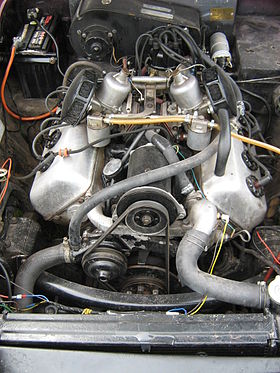Daimler V8 engines
| Daimler V8 | |
|---|---|

1963 Daimler SP250 V8 Engine
|
|
| Overview | |
| Manufacturer | The Daimler Company Limited |
| Production |
|
| Combustion chamber | |
| Configuration | 90 degree V eight-cylinder |
| Displacement |
|
| Cylinder bore |
|
| Piston stroke |
|
| Cylinder block alloy | Cast iron |
| Cylinder head alloy | Aluminium alloy |
| Valvetrain | OHV by pushrods and rockers from a single camshaft, two valves per cylinder, hemispherical head |
| Compression ratio |
|
| Combustion | |
| Fuel system | |
| Fuel type | Petrol |
| Oil system | Filter—Full flow replaceable element |
| Cooling system | Water |
| Output | |
| Power output |
|
| Torque output |
|
| Dimensions | |
| Length |
|
| Width |
|
| Height |
|
| Dry weight |
|
| Chronology | |
| Predecessor |
|
Daimler V-8 engines were designed for the Daimler Company by Edward Turner and produced from 1959 to 1969. Initially used in the SP250 sports car and the Majestic Major saloon, the engine was mostly used in the Daimler 2.5 V8 (later named V8-250) saloon made with Jaguar Mark 2 unit bodies from 1962 to 1969. Approximately 20,000 of the 2.5-litre version of the engine were made for use in the SP250 and the 250 saloon, while approximately 2,000 of the 4.5-litre version were made for use in the Majestic Major saloon and its limousine variant which remained in production until 1968.
Shortly after being appointed Managing Director (Chief Executive) of BSA's Automotive Division in 1956, Edward Turner was asked to design a saloon car powered by a V8 engine. Turner and his design engineer Jack Wickes began considering the initial concept of their new engine by examining the manual and spare parts list of a Cadillac V8 engine. Using a pushrod overhead valve system kept down design, development and production costs and allowed Turner to base the design of the cylinder head on those he developed for Triumph motorcycles including the use of hemispherical combustion chambers. Adapting the Triumph head design for use in a saloon car engine required much work in reducing friction and improving timing. Much of the development of the prototype engine was carried out by Dr. J. N. H. Tait. Tait had been involved with Donald Healey in the early post war years, working successfully on modified Riley 2½-litre Big Four engines, the final incarnation of which was used in 1953 Zethrin Rennsport prototype, delivering close to 200 bhp with surprising tractability.
...
Wikipedia
